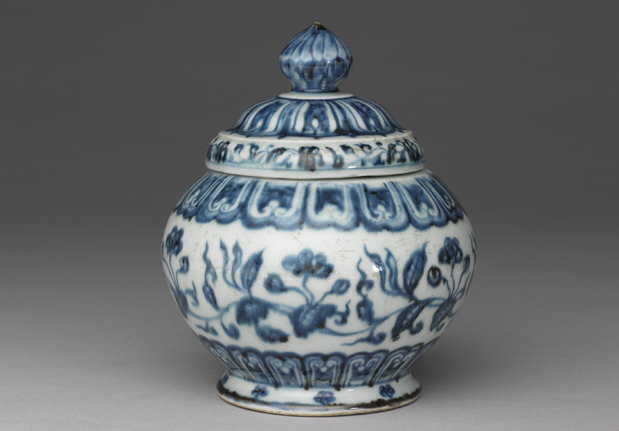Tea caddy in underglaze blue with Chinese begonia scrolls decor, Ming dynasty, Xuande reign (1426-1435)
- Image Number: K1B010939N000000000PAC
- Dynasty: Ming dynasty
- Category: Ceramics
- Function: Container
- Material: Minerals/Ceramics/
- Description:
The mouth is rounded and folded inward, with bulging belly, and the feet are turned outward, with a lotus bud and a new lid. The wall around the pot belly is painted with a pattern of flowering crabapple, while the upper and lower sides are decorated with a pattern of upside down lotus petals, and the left foot is painted with five petals and eight flowers. The covering surface is gradually enlarged in a three-step umbrella shape, the inner layer is the smallest blank, the middle part is lotus petal pattern, and the covering edge is the Malus rotundus flower. The inner attachment ring of the cover is along the circumference, and the wall edge is slightly higher to prevent the tank cover from slipping off. The bottom is flat in three steps, with the outer sole exposed, white and delicate. The blue and white flowers are thick and colorful, with brown green crystal defects. The white glaze is slightly bluish, and the glaze surface has many scratches. It is not recorded in the documents of the Ming Dynasty what this kind of jar was used for. As for the Qing Dynasty, it was often used with other tea utensils. In the painting of Emperor Qianlong’s Snow Scenery and Amusement in the Palace Museum in Beijing, the servants of the Emperor Qianlong were busy cooking Sanqing tea with snow water, which was similar to this one

![图片[2]-Tea caddy in underglaze blue with Chinese begonia scrolls decor, Ming dynasty, Xuande reign (1426-1435)-China Archive](https://chinaarchive.net/Ming dynasty/Ceramics/K1B010939N000000000PAC-52047.jpg)
![图片[3]-Tea caddy in underglaze blue with Chinese begonia scrolls decor, Ming dynasty, Xuande reign (1426-1435)-China Archive](https://chinaarchive.net/Ming dynasty/Ceramics/K1B010939N000000000PAC-52048.jpg)
Pictures & Images [HD] download
© Copyright
The copyright of the article belongs to the author, please keep the original link for reprinting.
THE END





